August 26, 2014 report
Researchers find ionic liquids able to safely penetrate both skin and bacteria biofilm

(Medical Xpress)—A team of medical researchers from several institutions in the U.S. has found that some ionic liquids are able to safely penetrate both skin and bacterial biofilms, opening the door to a possible breakthrough in the treatment of skin infections. In their paper published in Proceedings of the National Academy of Sciences, the team describes how they synthesized several ionic liquids and tested them on their ability to penetrate skin and bacterial biofilms, and also on their toxicity, and what they found as a result.
Non-responsive skin infections may not seem like much a big deal to people who have never had one, to those that have, especially the kind that last for months or years, they are a very big deal. The reason some skin infections don't heal is because they are protected by biofilms—a covering shield generated by the bacteria that serve as a barrier preventing antibiotics from reaching the infected tissue. In some cases, infections occur under the skin, and in those instances, the skin itself can serve as a barrier. Sadly, nearly eighty percent of all infections are associated with biofilms.
Scientists have been searching for a material that is able to penetrate both skin and biofilms carrying with it an antibacterial agent, all without harming the patient. Thus far, they haven't met with much success. In this new effort, the researchers believe they have found such a substance: ionic liquids, which are salts that are in a liquid state—in this case, at or near room temperature. The researchers synthesized several types and tested them to see which could penetrate both skin and biofilms. Those that could were then tested to see if they could kill two kinds of bacteria that cause real skin infections: Salmonella enterica and Pseudomonas aeruginosa. They found that one of their liquids was able to kill 99.9 percent of the bacteria present on a sample—that liquid, choline geranate, was also found to be non-toxic.
Further testing with a skin model revealed that the liquid was able to penetrate a biofilm and kill ninety five percent of present bacteria when paired with an antibiotic, compared to a kill rate of just 20 percent when the antibiotic was used alone. More testing will have to be done of course, but if the results found by the team thus far hold up, the discovery of ionic liquids as an infection therapy delivery vehicle could lead to a major medical breakthrough.
More information: Ionic liquids as a class of materials for transdermal delivery and pathogen neutralization, Michael Zakrewsky, PNAS, DOI: 10.1073/pnas.1403995111
Abstract
Biofilm-protected microbial infections in skin are a serious health risk that remains to be adequately addressed. The lack of progress in developing effective treatment strategies is largely due to the transport barriers posed by the stratum corneum of the skin and the biofilm. In this work, we report on the use of Ionic Liquids (ILs) for biofilm disruption and enhanced antibiotic delivery across skin layers. We outline the syntheses of ILs, analysis of relevant physicochemical properties, and subsequent neutralization effects on two biofilm-forming pathogens: Pseudomonas aeruginosa and Salmonella enterica. Further, the ILs were also examined for cytotoxicity, skin irritation, delivery of antibiotics through the skin, and treatment of biofilms in a wound model. Of the materials examined, choline-geranate emerged as a multipurpose IL with excellent antimicrobial activity, minimal toxicity to epithelial cells as well as skin, and effective permeation enhancement for drug delivery. Specifically, choline-geranate was comparable with, or more effective than, bleach treatment against established biofilms of S. enterica and P. aeruginosa, respectively. In addition, choline-geranate increased delivery of cefadroxil, an antibiotic, by >16-fold into the deep tissue layers of the skin without inducing skin irritation. The in vivo efficacy of choline-geranate was validated using a biofilm-infected wound model (>95% bacterial death after 2-h treatment). This work establishes the use of ILs for simultaneous enhancement of topical drug delivery and antibiotic activity.
© 2014 Medical Xpress
















